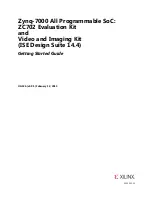17.3.1 Frame Format
The frame format used by the LEUART consists of a set of data bits in addition to bits for synchronization and optionally a parity bit for
error checking. A frame starts with one start-bit (S), where the line is driven low for one bit-period. This signals the start of a frame, and
is used for synchronization. Following the start bit are 8 or 9 data bits and an optional parity bit. The data is transmitted with the least
significant bit first. Finally, a number of stop-bits, where the line is driven high, end the frame. The frame format is shown in
17.2 LEUART Asynchronous Frame Format on page 544
.
S
0
1
2
3
4
5
6
7
[8]
[P]
Stop
Start or idle
Stop or idle
Frame
Figure 17.2. LEUART Asynchronous Frame Format
The number of data bits in a frame is set by DATABITS in LEUARTn_CTRL, and the number of stop-bits is set by STOPBITS in
LEUARTn_CTRL. Whether or not a parity bit should be included, and whether it should be even or odd is defined by PARITY in
LEUARTn_CTRL. For communication to be possible, all parties of an asynchronous transfer must agree on the frame format being
used.
The frame format used by the LEUART can be inverted by setting INV in LEUARTn_CTRL. This affects the entire frame, resulting in a
low idle state, a high start-bit, inverted data and parity bits, and low stop-bits. INV should only be changed while the receiver is disabled.
17.3.1.1 Parity Bit Calculation and Handling
Hardware automatically inserts parity bits into outgoing frames and checks the parity bits of incoming frames. The possible parity
modes are defined in
Table 17.1 LEUART Parity Bit on page 544
. When even parity is chosen, a parity bit is inserted to make the
number of high bits (data + parity) even. If odd parity is chosen, the parity bit makes the total number of high bits odd. When parity bits
are disabled, which is the default configuration, the parity bit is omitted.
Table 17.1. LEUART Parity Bit
PARITY [1:0]
Description
00
No parity (default)
01
Reserved
10
Even parity
11
Odd parity
See
for more information on parity bit handling.
17.3.2 Clock Source
The LEUART clock source is selected by the LFB bit field the CMU_LFCLKSEL register. The clock is prescaled by the LEUARTn bit-
field in the CMU_LFBPRESC0 register and enabled by the LEUARTn bit in the CMU_LFBCLKEN0. See
for
a diagram of the clocking structure.
To use this module, the LE interface clock must be enabled in CMU_HFBUSCLKEN0, in addition to the module clock.
EFM32JG1 Reference Manual
LEUART - Low Energy Universal Asynchronous Receiver/Transmitter
silabs.com
| Smart. Connected. Energy-friendly.
Preliminary Rev. 0.6 | 544


















